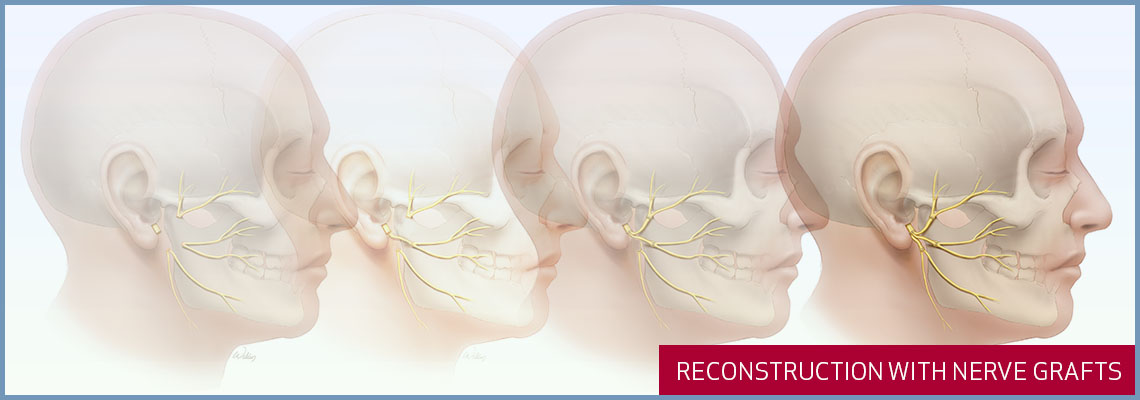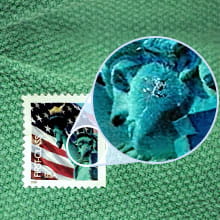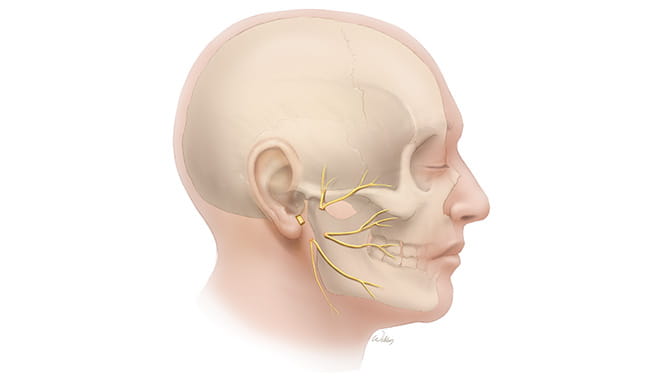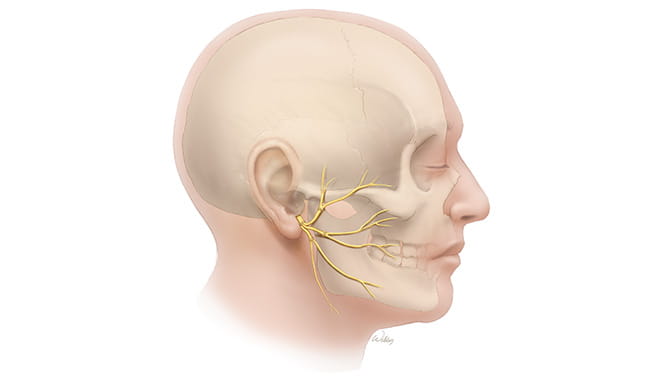Interposition Nerve Grafts

Direct repair of a divided facial nerve is the procedure of choice if circumstances permit. A facial nerve that has been sharply transected during trauma or sacrificed during surgery can often be repaired primarily utilizing microsurgical techniques. Under the magnification of an operating microscope, the cut ends of the nerve can be reunited with stitches that are finer than a hair (10-0 nylon).

The repaired nerve now begins the regeneration process, re-growing from the site of injury at a rate of approximately 1mm/day, or one inch a month. It is imperative that the nerves are united without tension. If the gap between the nerve ends is to large to permit a tension-free repair, then an interposition graft must be used to guide the regenerating nerve fibers (axons).
An expendable segment of sensory nerve harvested from the calf (sural nerve graft) or neck (great auricular nerve) is frequently used to bridge the gap (nerve graft). These interpostion nerve grafts are often utilized to reconstruct the facial nerve after cancer surgery where complete removal of the tumor necessitates the sacrifice of a facial nerve segment (for example in the surgical care of parotid tumors).
Technique
The sural nerve is frequently utilized as a source of nerve graft. The sural nerve is lengthy and can be retrieved through a series of small incisions in the posterior calf and ankle. The sural nerve provides sensation to the lateral ankle but does not provide motor power to the muscles of the leg.
When the sural nerve is utilized as a graft, a region of numbness along the lateral ankle results but the strength in the leg and foot should not be diminished. The freed sensory nerve is now utilized to fill the gap between the cut ends of the facial nerve. Microneurosurgical connections are now created with the aid of an operation microscope and specialized instruments.
Technique
The sural nerve is frequently utilized as a source of nerve graft. The sural nerve is lengthy and can be retrieved through a series of small incisions in the posterior calf and ankle. The sural nerve provides sensation to the lateral ankle but does not provide motor power to the muscles of the leg.
When the sural nerve is utilized as a graft, a region of numbness along the lateral ankle results but the strength in the leg and foot should not be diminished. The freed sensory nerve is now utilized to fill the gap between the cut ends of the facial nerve. Microneurosurgical connections are now created with the aid of an operation microscope and specialized instruments.
If long nerve grafts are desired to span the entire face and unite the right and left facial nerves (cross face nerve graft), then both sural nerves may be utilized.
The great auricular nerve is another potential donor for interposition nerve grafting. The great auricular nerve--like the sural nerve--is a sensory branch and provides no motor function to adjacent muscles. The great auricular nerve is usually harvested through an anterolateral neck incision but can be retrieved through a submandibular incision during partial hypoglossal nerve transfers. A nerve segment measuring approximately 10 cm in length can be obtained from most adults and is ample for many facial nerve procedures.
A numb ear lobe is an unavoidable byproduct of the great auricular nerve graft that is usually well tolerated. Additionally, the XI cranial nerve that assists with shoulder elevation and turning of the head runs in close proximity to the great auricular nerve and may rarely be impaired or damaged during the harvest of the nerve graft.
Recovery
The length of hospitalization and period of recovery are largely determined by the cause of the facial nerve paralysis and can vary widely. Recovery is strongly influenced by the distance the regenerating nerve will have to travel before reaching the muscles of facial expression. Age, nutritional status, smoking history and general health also influence the rate of recovery. Physical therapy and electrical stimulation are often initiated as facial motion begins to recover.
The great auricular nerve is another potential donor for interposition nerve grafting. The great auricular nerve--like the sural nerve--is a sensory branch and provides no motor function to adjacent muscles. The great auricular nerve is usually harvested through an anterolateral neck incision but can be retrieved through a submandibular incision during partial hypoglossal nerve transfers. A nerve segment measuring approximately 10 cm in length can be obtained from most adults and is ample for many facial nerve procedures.
A numb ear lobe is an unavoidable byproduct of the great auricular nerve graft that is usually well tolerated. Additionally, the XI cranial nerve that assists with shoulder elevation and turning of the head runs in close proximity to the great auricular nerve and may rarely be impaired or damaged during the harvest of the nerve graft.
Recovery
The length of hospitalization and period of recovery are largely determined by the cause of the facial nerve paralysis and can vary widely. Recovery is strongly influenced by the distance the regenerating nerve will have to travel before reaching the muscles of facial expression. Age, nutritional status, smoking history and general health also influence the rate of recovery. Physical therapy and electrical stimulation are often initiated as facial motion begins to recover.
real patient case studies
Learn how facial paralysis surgery and functional restoration can help you.


